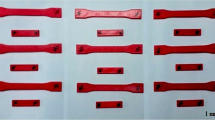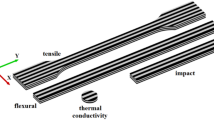Fe-powder and paraffin-based or similar systems are widely used for low-temperature injection molding. The main attention of research efforts on such compositions is focused on the study of their rheology. At the same time, such materials can be adapted for 3D printing by layer-by-layer surfacing, requiring only necessary rods or filaments with a sufficient level of mechanical properties so as not to break during printing. Hence, this paper examines the influence of paraffin content on the compressive strength of samples made of carbonyl iron powder and paraffin in the ratio: 50/50, 60/40, 70/30, and 80/20 vol.%. Computer calculations of critical deformation, elasticity modulus, and compressive strength of such composites have been performed. According to the examination and calculation results, the modulus of elasticity varies from 1358 to 113 MPa with a higher paraffin content, the critical deformation ranges between 0.257 and 3.310, and the compressive strength is between 0.339 and 0.761 MPa. Iron powder was mixed with paraffin in a planetary mill for 3 min with a subsequent sieving of the mixture. Afterward, pressed cylindrical samples with a volume of ~1 cm3 and a height of ~10 mm were used to determine the density and compressive strength. It was found that the density of the samples after pressing is 1.3 times lower than the calculated by the additivity formula at a binder content of 20 vol.%. Only when the binder content increases to 50 vol.%, the actual density approaches the calculated values, that is, the relative porosity varies from 0.212 to 0. With an increase in paraffin content from 20 to 50 vol.% the strength of the samples increases along the concave curve from 3 to 11 MPa. The dependences of the calculated and experimentally obtained compressive strength are similar, indicating the adequacy of the established models. However, significant variation in values is due to the difference between the properties of paraffin under study and that used for testing. Samples of rods with 40 and 60 vol.% Fe was extruded and tested by 3D printing. The obtained experimental data can be used in the creation of other similar working materials for 3D printing in the layer-by-layer surfacing.








Similar content being viewed by others
References
N. Cruz, L. Santos, J. Vasco, and F.M. Barreiros, “Binder system for fused deposition of metals,” in: Proceedings of the Euro PM2013: Congress & Exhibition (15–18 September 2013, Gothenburg, Sweden), EPMA, Athens, Greece (2013), pp. 79–84; DOI: https://www.epma.com/publications/euro-pmproceedings/product/ep13021.
A.A. Tafti, V. Demers, G. Vachon, and V. Brailovski, “Effect of binder constituents and solids loading on the rheological behavior of irregular iron-based feedstocks,” J. Manufacturing Sci. Eng., 143, No. 3, 12 (2021); https://doi.org/10.1115/1.4048268
K.C. Hsu, C.C. Lin, and G.M. Lo, “The effect of wax composition on the injection molding of car- bonyl iron powder with LDPE,” Canadian Metallurgical Quarterly, 35, No. 2, 181–187 (1996); DOI: https://doi.org/10.1179/cmq.1996.35.2.181.
Y. Li, B. Huang, and X. Qu, “Viscosity and melt rheology of metal injection moulding feedstocks,” Powder Metal., 42, No. 1, 86–90 (1999); DOI: https://doi.org/10.1179/pom.1999.42.1.86.
ISO/ASTM52900-15, Standard Terminology for Additive Manufacturing–General Principles–Terminology, ASTM International, West Conshohocken, PA (2015); https://doi.org/10.1520/ISOASTM52900-15.
J. Gonzalez-Gutierrez, S. Cano, S. Schuschnigg, C. Kukla, J. Sapkota, and C. Holzer, “Additive manufacturing of metallic and ceramic components by the material extrusion of highly-filled polymers: A review and future perspectives,” Materials., No. 11, 840–876 (2018). https://doi.org/10.3390/ma11050840.
Yu.M. Panishko, V.I. Kovtsun, R.S. Kozi, and V.V. Tarasov, “Complex characteristics of beeswax (Review of the literature),” in: Healthy Way of Life: A collection of scientific articles [in Ukrainian], Lviv (2010), 49, p. 20–25.
P.N. Kadiresh, “Mechanical characteristics of paraffin Wax-HTPB based hybrid rocket fuel,” in: Proc. of Int. Conf. of Aerospace and Mechanical Engineering (2019), pp. 91–103; https://link.springer.com/chapter/10.1007%2F978-981-15-4756-09.
N. Guo and M.C. Leu, “Additive manufacturing: Technology, applications and research needs,” Frontiers Mechanical Eng., No. 8, 215–243 (2013); https://doi.org/10.1007/s11465-013-0248-8.
O.B. Zgalat-Lozynskyy, O.O. Matviichuk, O.I. Tolochyn, O.V. Ievdokymova, N.O. Zgalat-Lozynska, and V.I. Zakiev, “Polymer Materials Reinforced with Silicon Nitride Particles for 3D Printing,” Powder Metall. Met. Ceram., 59, No. 9–10, 515-527 (2020).
S. Ryu, S. Han, J. Kim, H. Moon, J. Kim, and S.W. Ko, “Tensile and compressive strength characteristics of Aluminized Paraffin Wax Fuel for various particle size and contents,” J. Korean Soc. Propulsion Eng., 20, No. 5, 70–76 (2016); DOI:https://doi.org/10.6108/KSPE.2016.20.5.070.
O. A Kiseleva, Polystructural Theory of Strength of Composite Materials: the Method [in Russian], TSTU, Tambov (2013), p. 22.
T.A. Palamarchuk, A.A. Yalanskiy, N.T. Bobro, and A.N. Seleznev, “Features of mechanical theories of strength of composite materials,” in: Geotechnical Mechanics [in Ukrainian], IGTM NAS of Ukraine, Dnipro, Issue 119, 145–156 (2014); http://dspace.nbuv.gov.ua/handle/123456789/137476.
Veale Kirsty, Adali Sarp, Pitot Jean, and Bemont Clinton, “The structural properties of paraffin wax based hybrid rocket fuels with aluminium particles,” Acta Astronautica, 151, 864–873 (2018); DOI:https://doi.org/10.1016/j.actaastro.2018.07.042
T. DebRoy, H.L. Wei, J.S. Zuback, T. Mukherjee, J.W. Elmer, J.O. Milewski, A.M. Beese, A. Wilson-Heid, A. De, and W. Zhang, “Additive manufacturing of metallic components – Process, structure and properties,” Progress Mater. Sci., 92, 112–224 (2018); DOI: https://doi.org/10.1016/j.pmatsci.2017.10.001.
L.E. Ivanovskii, Encyclopedia of Waxes. Vol. 1: Waxes and Their Most Important Properties [Russian translation from German by V. V. Zotova], Gostoptekhizdat, Leningrad (1956), p. 146.
G. Pu, J. Wang, and S.J. Severtson, “Properties of paraffin wax / montmorillonite nanocomposite coatings,” in: NSTI Nanotechnology Conference and Trade Show – NSTI Nanotech 2007: Technical Proceedings, Vol. 2 (2007), pp. 112–115.
V.T. Kochetov, Resistance of Materials [in Russian], Rostov (1987), p. 400.
Edward A. Druschitz, Investment Shell Cracking, Missouri S&T (2009), p. 68.
MatWeb: Online Materials Information Resource [Electronic resource]. Access mode:www.matweb.com.
L.P. Canal Casado, Experimental and Computation Micromechanical Study of Fiber-Reinforced Polymers, Polytechnic University of Madrid (2011), p. 182.
N. Mohan, P. Senthil, S. Vinodh, and N. Jayanth, “A review on composite materials and process parameters optimisation for the fused deposition modelling process,” Virtual and Physical Prototyping, 12, No. 1, 47–59 (2017); https://doi.org/10.1080/17452759.2016.1274490.
X. Yan, L. Hao, W. Xiong, and D. Tang, “Research on influencing factors and its optimization of metal powder injection molding without mold via an innovative 3D printing method,” Royal Soc. Chemistry Advances., 7, 55232–55239 (2017); DOI: https://pubs.rsc.org/en/content/articlehtml/2017/ra/c7ra11271h.
Acknowledgements
We express our sincere gratitude to the specialists of PJSC PlazmaTech (Ukraine, Kiev), the Electron Microscopy Center of E.O. Paton Institute of Materials Science and Welding, National Technical University of Ukraine ‘Igor Sikorsky Kyiv Polytechnic Institute,’ and Materials Lab LLC (Kyiv, Ukraine).
Author information
Authors and Affiliations
Corresponding author
Additional information
V.P. Bondarenko is deceased.
Translated from Poroshkova Metallurgiya, Vol. 59, Nos. 11–12 (536), pp. 146–155, 2020.
Rights and permissions
About this article
Cite this article
Bondarenko, V., Ievdokymova, O., Matviichuk, O. et al. Iron–Paraffin Composite Material for 3D Printing by Fused Deposition Modeling Method. Powder Metall Met Ceram 59, 730–738 (2021). https://doi.org/10.1007/s11106-021-00208-2
Received:
Published:
Issue Date:
DOI: https://doi.org/10.1007/s11106-021-00208-2




